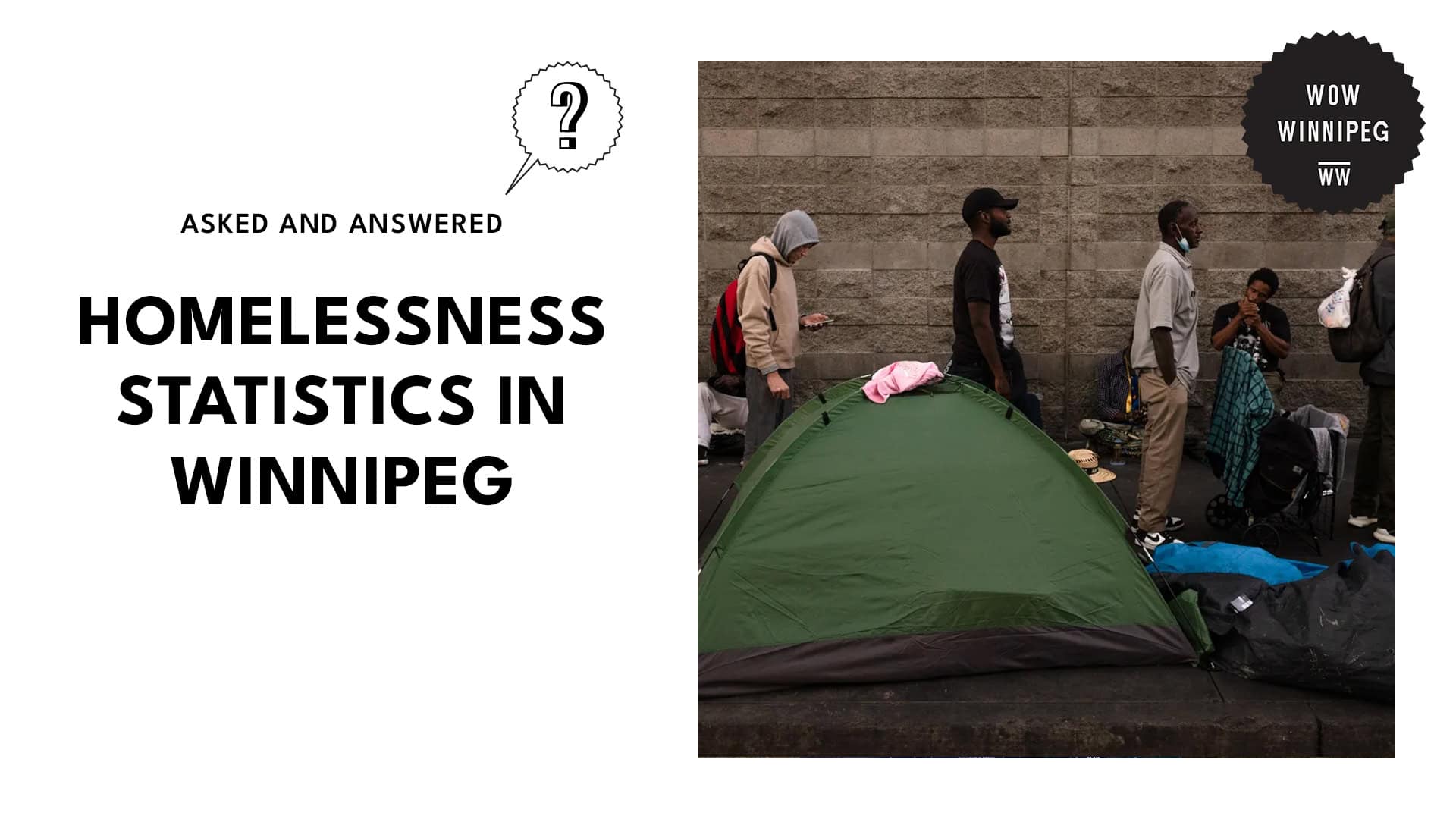Homelessness in Winnipeg by the Numbers: Statistics and Insights
Key Insights
| According to End Homelessness Winnipeg, lack of income for housing was the largest cause of homelessness in Winnipeg in 2022. Data from the 2022 Winnipeg Street Census reveals that more than 1,250 individuals identified as homeless in Winnipeg. The same census also shows that the age group 30-49 makes up most of the homeless in Winnipeg, at 45.50% of the total population. AreaVibes reports that Heubach Park and Old Tuxedo are Winnipeg’s most expensive neighborhoods, with a cost of living that is 20% higher than the city average. The Everyone Counts 2020-2022 study reveals that across Manitoba, Winnipeg recorded the highest number of homeless individuals when compared to Thompson’s 135 and Brandon’s 150. |
Data from End Homeless Winnipeg shows that homelessness in the city continues to be a complex issue that affects citizens.
In 2022, Winnipeg had over 1,250 people who identified as experiencing homelessness. This number includes individuals in emergency shelters, transitional housing, and unsheltered locations.
Homelessness in Winnipeg is connected to a variety of causes that go beyond the lack of shelter. For those who reported losing their home, the primary cause was economic difficulty.
175 individuals, or 29.2% of the homeless, reported lacking sufficient income to cover housing expenses. This indicates that the city has a housing affordability problem, as wages fail to keep up with increasing rental prices.
Meanwhile, household conflict is another cause of homelessness in the city. 153 individuals, or 25.5%, reported disagreements with a partner, friend, family member, or others as the reason for their loss of housing.
Similarly, disagreement with roommates and landlords, or eviction by threat of renovation was another frequently mentioned problem. This was cited by 104 people or 17.3% of the homeless population.
Another 110, or 18.3%, mentioned substance use problems as a cause. These issues frequently overlap with other vulnerabilities, such as mental illness, unemployment, and difficulty maintaining regular care.
Other causes were less common but still relevant. 46 individuals were made homeless due to unsafe housing conditions, 38 through mental health issues, and 36 due to incarceration.
Physical health problems, domestic violence, the COVID-19 pandemic, discrimination, and hospitalization were also cited as reasons by other respondents.
These results show that homelessness in Winnipeg is not triggered by a single cause but rather by financial, social, and health-related issues.
| Cause of Housing Loss | Frequency | Percentage |
| Not Enough Income for Housing | 175 | 29.20% |
| Conflict with Partner, Friend, Family, CFS, or Other | 153 | 25.50% |
| Substance Use Issue | 110 | 18.30% |
| Conflict with Roommate, Landlord, or Renovations | 104 | 17.30% |
| Unsafe Housing | 46 | 7.70% |
| Mental Health Issue | 38 | 6.30% |
| Physical Health Issue | 20 | 3.30% |
| Incarceration | 36 | 6.00% |
| Experienced Abuse (Partner or Family) | 16 | 2.70% |
| Experienced Discrimination/Intergenerational Effects | 9 | 1.50% |
| Pandemic | 15 | 2.50% |
| Hospitalization/Treatment Program | 10 | 1.70% |
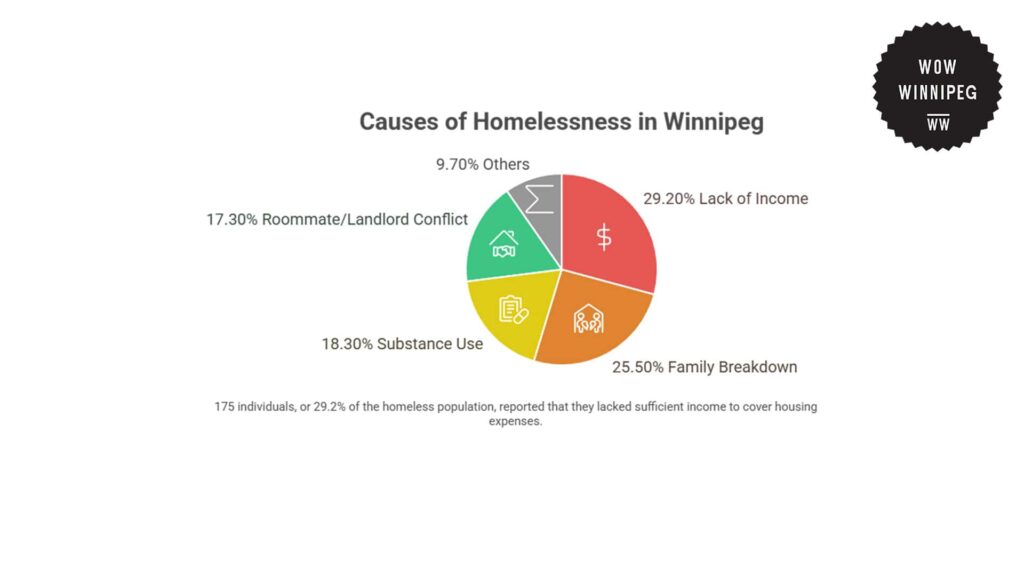
Where Homeless Individuals in Winnipeg Stay
The 2022 Winnipeg Street Census shows that individuals who are homeless in Winnipeg are spread over a variety of living arrangements.
Emergency shelters had the largest number of homeless individuals. 422 people, or one-third of the sample, were residing in places like family shelters, youth facilities, or domestic violence survivor programs.
These places offer necessary overnight shelter and minimal support services but are intended for short-term stays and do not offer long-term housing stability.
Another 405 people were categorized as provisionally accommodated. This includes those housed temporarily in transitional programs, institutional care, hotels, or living temporarily with others.
These types of arrangements can provide temporary relief but also often do not have the security, stability, or legal protection of formal housing.
A smaller number of 123 individuals were unsheltered, residing in areas not intended for human habitation like streets, parks, or abandoned structures.
This population has the most direct exposure to harm and frequently has no access to even the most rudimentary services.
Additionally, 306 individuals have unknown locations. These people could be shifting from place to place within temporary shelters, sleeping in their cars, or residing in environments that do not get reported.
Overall, these numbers indicate a pressing demand for improved tracking, broader shelter solutions, and long-term housing solutions.
| Category | Count |
| Unsheltered | 123 |
| Emergency Sheltered | 422 |
| Provisionally Accommodated | 405 |
| Unknown Location | 306 |
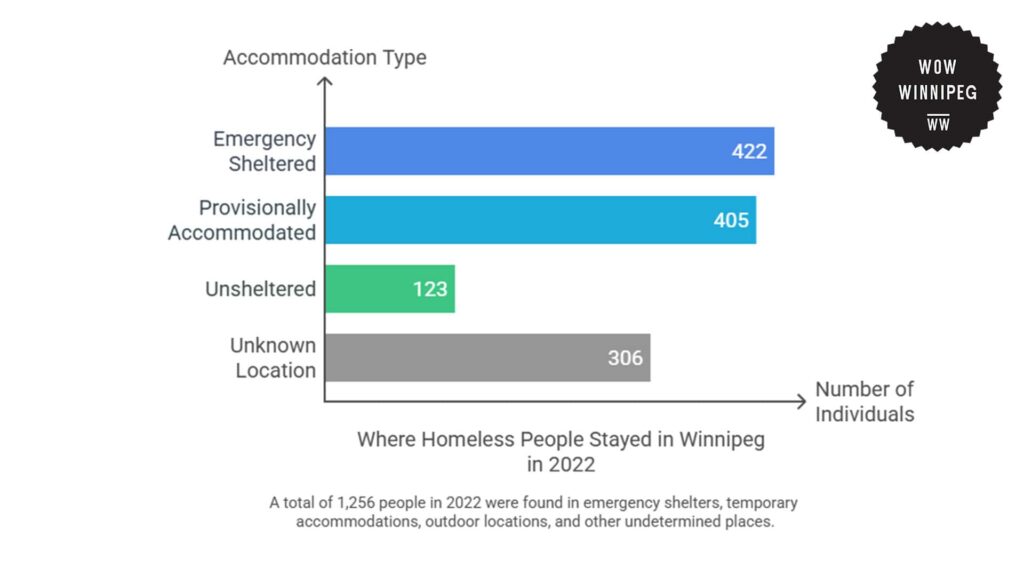
Regional Analysis of Homelessness Across Manitoba
Data from the Everyone Counts 2020-2022 report illustrates how homelessness across cities in Manitoba varies depending on population size, geographic location, local conditions, and available services.
Although the problem of homelessness exists throughout the province, the data indicates that Winnipeg holds the majority of Manitoba’s homeless population, followed by Brandon and Thompson.
As the capital city and largest urban center, Winnipeg recorded 1,256 persons experiencing homelessness.
This high number is not only caused by the city’s larger population. It is also affected by the city’s status as a hub for social services, shelters, and transitional housing programs for the entire region.
Thompson, a smaller city in northern Manitoba, had a homeless count of 138. While the overall number was lower, a much higher percentage, at 36%, were unsheltered.
This indicates service gaps within the city, where shelter and transitional program access is still limited. In contrast, 64% of those tallied were in transitional housing, indicating a heavy use of temporary shelters in Thompson.
Brandon, the province’s second-largest city, reported an estimated 150 people being homeless. Similar to Thompson, Brandon also has a high rate for unsheltered individuals, at 40%.
This illustrates that even with its size and available resources, the city still faces challenges with access to permanent housing and shelter for those at risk.
Moreover, these numbers show that while larger urban areas might report higher numbers of overall homelessness, smaller towns and communities tend to experience more difficulties.
Fewer housing facilities, reduced outreach services, and geographical remoteness can all be factors leading to the higher rates of unsheltered homelessness reported outside of Winnipeg.
| Region | Total Homeless Population | Sheltered (%) | Unsheltered (%) |
| Winnipeg | 1,256 | 52.6% | 10% |
| Thompson | 138 | 64% | 36% |
| Brandon | 150 | 60.00% | 40% |
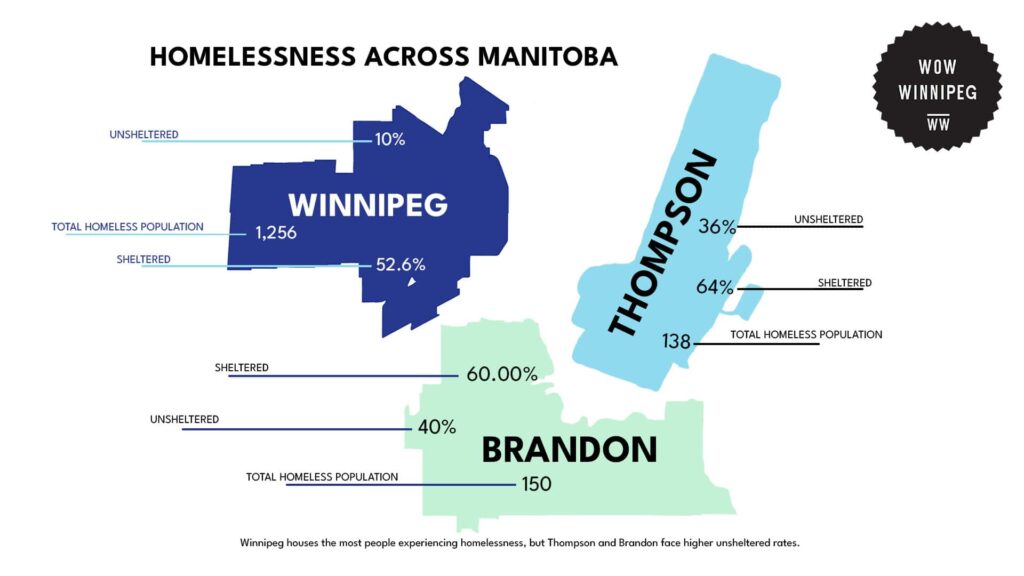
Most Expensive Neighborhoods in Winnipeg
A report by AreaVibes shows how Winnipeg’s cost of living contributes significantly to the issue of housing instability and homelessness patterns in the city.
Although the citywide cost of living index is at 78, some neighborhoods are well over this number, creating affordability barriers that restrict where individuals with lower incomes can afford to reside.
Heubach Park and Old Tuxedo are the city’s priciest neighborhoods. They each have cost of living scores of 94, which is 20% more than the city average.
They also have smaller populations, with 511 residents in Heubach Park and 985 in Old Tuxedo. Their high cost of living comes mostly from expensive housing markets that feature few available rentals and much higher property prices.
Similarly, Tuxedo, China Town, The Forks, and Wellington Crescent each have a cost of living index of 93, or 19% over the city average. Tuxedo also has the highest population among Winnipeg’s most expensive neighborhoods.
All four of these neighborhoods have high prices that place them beyond the reach of most residents, especially those with limited or unstable incomes.
Meanwhile, West Fort Garry Industrial, Linden Ridge, Saint Vital Perimeter South, and Wilkes South have cost indexes ranging from 90 to 91, which is 15% to 17% higher than the city average.
Although these communities might have more range in the types of homes available, they are still far from being considered affordable areas for most people in the city.
At the same time, these neighborhoods also drive up costs for the rest of the city while limiting accessible and affordable housing options for many residents.
For individuals who are experiencing or are at risk of homelessness, these cost disparities present significant barriers to affordable housing.
| Rank | Neighborhood | Population | Cost of Living Index | % Higher than Winnipeg Average (78) |
| 1 | Heubach Park | 511 | 94 | 20% |
| 2 | Old Tuxedo | 985 | 93 | 20% |
| 3 | Tuxedo | 2,717 | 93 | 19% |
| 4 | China Town | 594 | 93 | 19% |
| 5 | The Forks | 341 | 93 | 19% |
| 6 | Wellington Crescent | 1,698 | 93 | 19% |
| 7 | West Fort Garry Industrial | 175 | 91 | 17% |
| 8 | Linden Ridge | 1,973 | 90 | 15% |
| 9 | Saint Vital Perimeter South | 2,027 | 90 | 15% |
| 10 | Wilkes South | 1,071 | 90 | 15% |
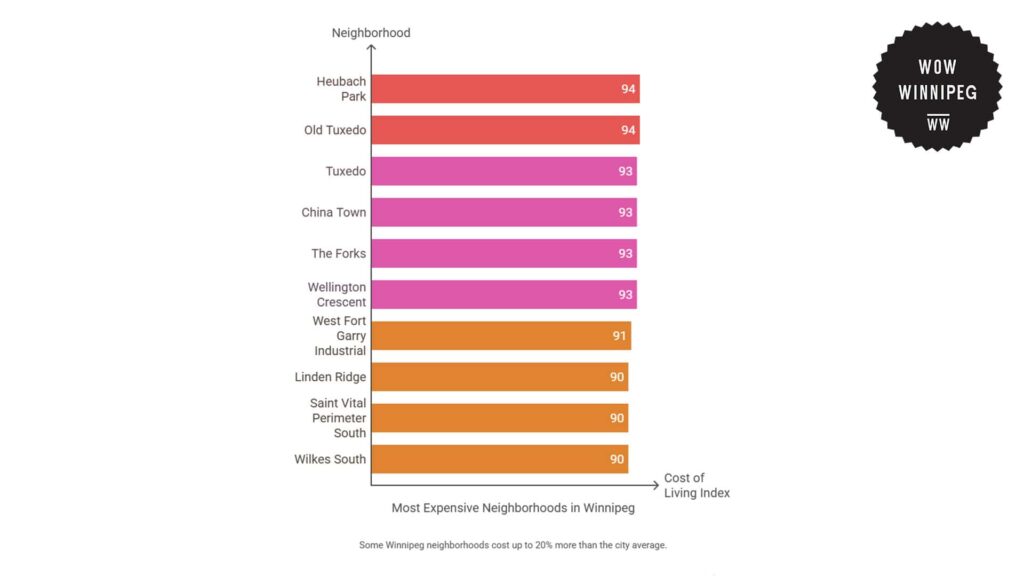
Demographic Breakdown of Homelessness Trends in Winnipeg
The 2022 Winnipeg Street Census illustrates how homelessness affects different demographic groups disproportionately.
Homelessness by Age
In Winnipeg, the adult group aged 30 to 49 forms the majority of the homeless, at 45.5% of the total population.
Individuals from this group are usually in the labor force but could also be experiencing income volatility, unemployment, and housing issues that lead to homelessness.
Younger adults between 25 and 29 account for 8.9% of homeless people, while those between 20 and 24 years account for 7.5%. These individuals are also of working age and could be experiencing similar problems related to low income and unemployment.
Meanwhile, young people between 16 and 19 years account for 7.9% of the homeless population. This number includes vulnerable youth, like those aging out of care systems or experiencing limited work opportunities.
Those over the age of 50 account for 13.2% of the homeless population. While this is a smaller overall number, older people also deal with other vulnerabilities like chronic diseases and limited employment opportunities that further cause homelessness.
| Age Group | Percentage of Homeless Population |
| Under 16 | Not surveyed |
| 16–19 | 7.90% |
| 20–24 | 7.50% |
| 25–29 | 8.90% |
| 30–49 | 45.50% |
| 50+ | 13.20% |
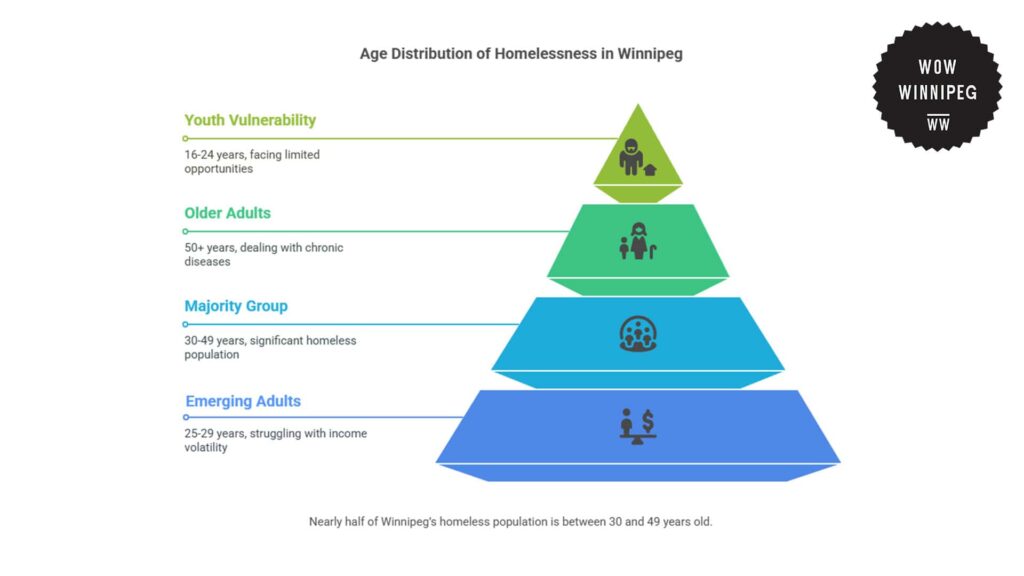
Homelessness by Gender
The data also shows that homelessness in Winnipeg is disproportionate across genders.
Most homeless individuals are male, representing 62.6% of the population. Meanwhile, 35.4% of the city’s homeless population consists of women.
Although fewer women are counted in the streets or shelters, they frequently endure hidden homelessness. This includes staying with family and friends, or in unsafe housing to evade the dangers of sleeping on the streets.
Women are also more likely to endure housing loss resulting from domestic violence by family members or partners.
Individuals identifying as non-binary or other genders make up 2% of the homeless population.
Although this is smaller in percentage, this group tends to experience higher risks from discrimination, a lack of inclusive services, and restricted shelter sources that acknowledge or accept gender diversity.
| Gender | Percentage of Homeless Population |
| Male | 62.60% |
| Female | 35.40% |
| Non-binary/Other | 2.00% |
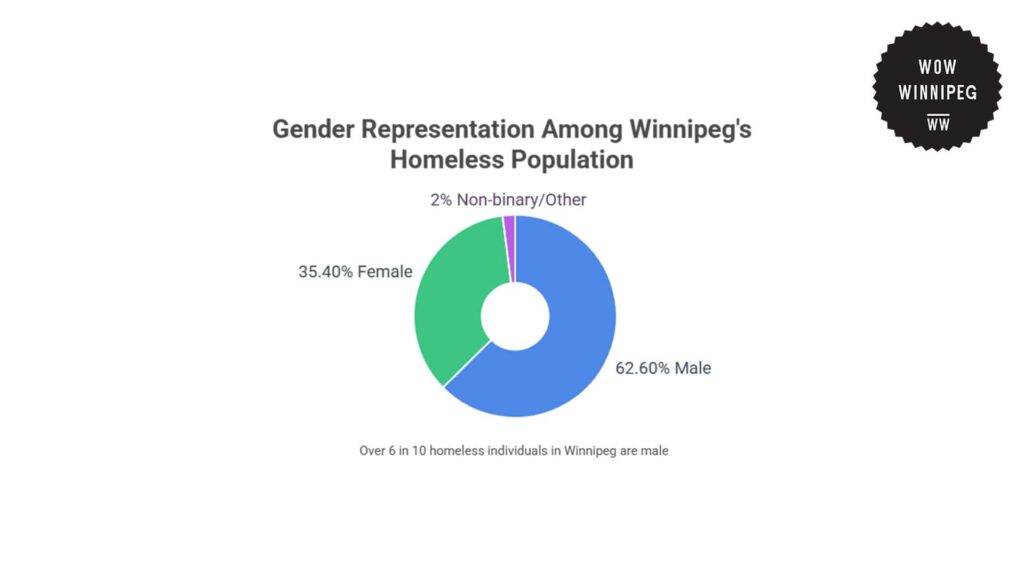
Costs and Consequences of Homelessness in Winnipeg
The Homeless Hub reports that homelessness in Winnipeg is an expensive burden for public systems, with an estimated cost of $32,000 to $41,000 per annum for each homeless individual.
These expenses often come from the extended use of emergency services that were never meant to be long-term solutions to homelessness.
Among all the expenses, the use of shelters incurs the largest costs. Each year, it costs between $15,000 and $20,000 to support one person in an emergency shelter.
This includes staffing, round-the-clock operations, food provision, and the physical infrastructure needed to accommodate a growing population.
As more people come in and out of these facilities, the need for increased capacity and resources grows. However, this investment still does not address the root causes of homelessness.
Meanwhile, medical costs follow as the next most expensive category. This is partly because homeless individuals experience conditions that are not treated immediately or are worsened by their unstable living situations.
For example, some homeless individuals may experience infections, respiratory issues, or mental illness. Thus, they often rely on emergency departments for care, and these hospitalizations and inpatient visits can cost $10,000 to $12,000 per individual annually.
The impacts on the justice system are also costly through low-level offenses, public counsels, or unpaid fines. These cost an estimated $7,000 to $9,000 per individual annually, taking away more resources from the community.
Overall, these numbers show how homelessness drives a high-cost, short-term approach within the areas of housing, health care, and law enforcement.
| Category | Cost Per Individual (Annual) | Total Cost (Annual) |
| Emergency Shelter Services | $15,000–$20,000 | ~$18 million |
| Healthcare Costs (ER Visits, etc.) | $10,000–$12,000 | ~$12 million |
| Justice System Interactions | $7,000–$9,000 | ~$9 million |
| Total | $32,000–$41,000 | ~$39 million (estimated) |
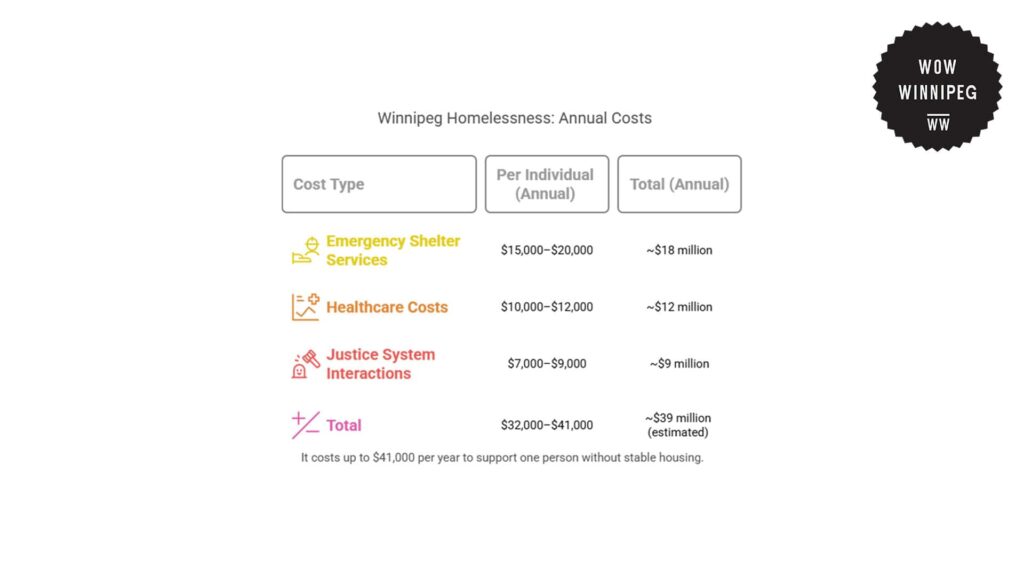
Interventions and Solutions to Homelessness in Winnipeg
The Government of Winnipeg has created the Reaching Home: Winnipeg Homelessness Plan 2019–2024 strategy for addressing homelessness in the long run.
The biggest chunk of the plan’s budget, at 21%, goes to Housing Services. This category finances programs like rapid rehousing and continuous support that assist individuals in moving into and remaining in permanent housing.
Meanwhile, Prevention and Shelter Diversion programs are meant to prevent individuals from becoming homeless in the first place.
This would cover mediation of conflict, prevention of eviction, and monetary assistance for those at imminent risk of losing their housing.
Support Services offer vital help beyond shelters. These consist of mental health counseling, case management, employment initiatives, and life skills education.
Capital Investments form another pillar of this initiative, as they finance the development of new dwelling units, renovations on existing structures, and infrastructure to accommodate demand from more individuals.
The city’s plan hopes to stop homelessness by doing more than providing short-term relief. With investments on every front, the aim is to construct a system that not only addresses homelessness but strives to eradicate it.
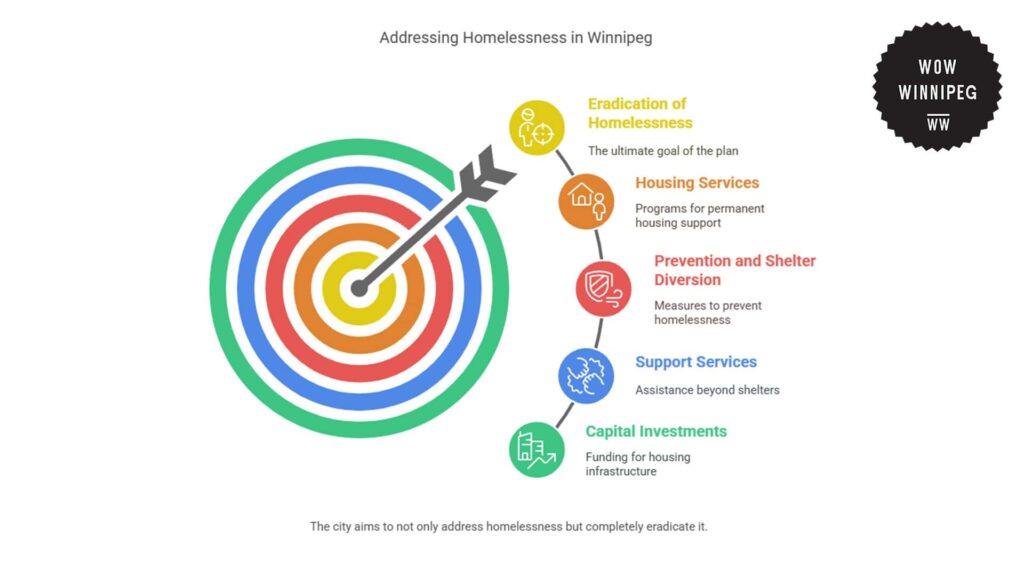
The Future of Homelessness in Winnipeg
Despite recent attempts to grow housing programs, homelessness in Winnipeg will likely be a chronic issue in the future.
Achieving long-term housing goals and improving support services will be essential to decreasing the number of people in shelters.
Statistics from End Homelessness Winnipeg indicate that between April 1, 2022, and the close of 2024, a combined total of 1,346 individuals were placed into housing through Housing First and Non-Housing First streams funded by Reaching Home.
Without increased shelter space, more affordable housing, and sustained wraparound services, too many will still come to rely on emergency systems to survive.
This shows that there is a need for more solutions that prevent homelessness from occurring in the first place and ensure that housing placements become more stable over time.
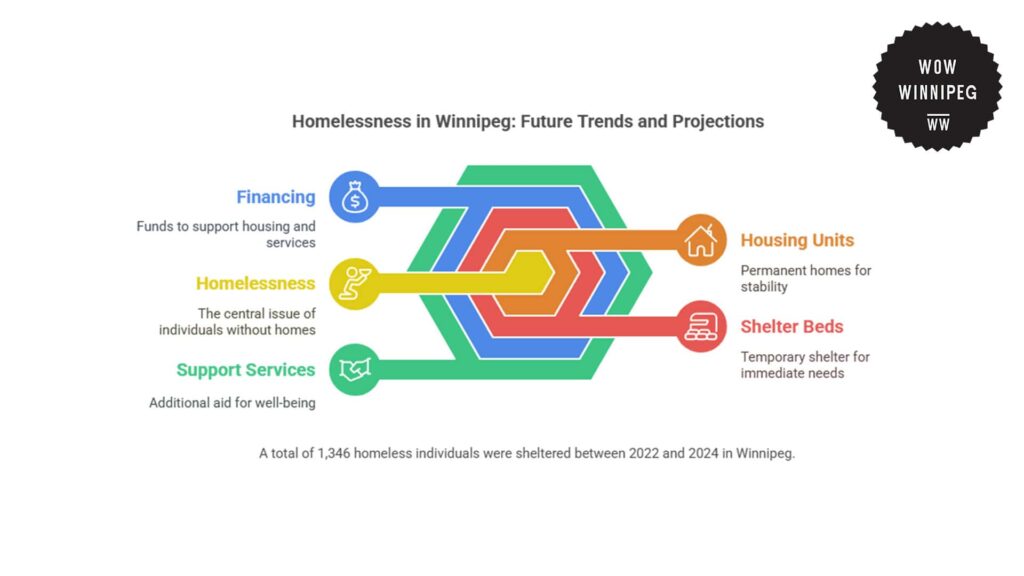
References
- End Homelessness Winnipeg. (n.d.). Winnipeg Street Census. Retrieved from https://endhomelessnesswinnipeg.ca/street-census/
- Infrastructure Canada. (2022). Everyone Counts: Point-in-Time Count Results (2020–2022). Retrieved from https://housing-infrastructure.canada.ca/homelessness-sans-abri/reports-rapports/pit-counts-dp-2020-2022-results-resultats-eng.html
- Canadian Observatory on Homelessness. (n.d.). Community Profile: Brandon. Retrieved from https://homelesshub.ca/community_profile/brandon/
- Canadian Observatory on Homelessness. (n.d.). Community Profile: Thompson. Retrieved from https://homelesshub.ca/community_profile/thompson/
- Canadian Observatory on Homelessness. (n.d.). Community Profile: Winnipeg. Retrieved from https://homelesshub.ca/community_profile/winnipeg/
- AreaVibes. (n.d.). Most Expensive Neighborhoods in Winnipeg, MB. Retrieved from https://www.areavibes.com/winnipeg-mb/most-expensive-neighborhoods/
- Canadian Observatory on Homelessness. (2019). Reaching Home: Winnipeg Homelessness Plan 2019–2024. Retrieved from https://homelesshub.ca/resource/reaching-home-winnipeg-homelessness-plan-2019-2024/

